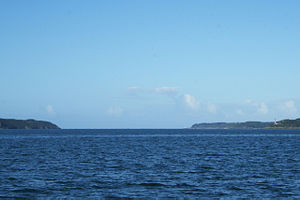

The Goulet de Brest (French pronunciation: [ɡulɛ də bʁɛst]) is a 3-km-long strait linking the roadstead of Brest to the Atlantic Ocean. Only 1.8 km wide, the goulet is situated between the Pointe du Petit Minou and the Pointe du Portzic to the north and the îlot des Capucins and the Pointe des Espagnols to the south.
At each turn of the tide, the ocean refills the roadstead in a current that can attain 4 to 5 knots.[1] Sailing ships would thus wait in the cove of Camaret-sur-Mer for a favourable current to carry them into the goulet.
On 2 January 1793, the Childers Incident – the first shots of the war between Great Britain and France during the French Revolutionary Wars – took place in the goulet.
- ^ Michel Dion (1996). Batteries, réduits, tours, forts, casemates... de Camaret et Roscanvel (in French). Brest: Association du Mémorial Montbarey. p. 67.